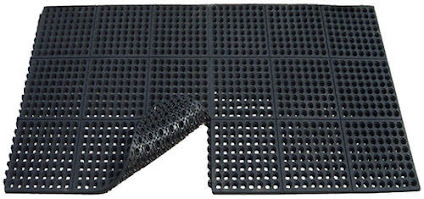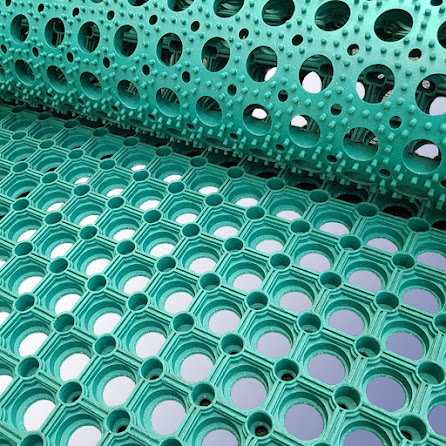Outdoor Matting
Outdoor Rubber Flooring is the ideal surfacing option for outdoor flooring due to its ability to perform exceptionally well in the face of environmental conditions and changes. Placing rubber outside mats over your deck floors or patio floors will help protect them against physical damage and from the damaging forces of nature such as moisture and direct sunlight. Rubber possesses physical qualities, such as resistance to moisture and changing weather conditions, that makes it a great material for outdoor matting. Additionally, outdoor rubber flooring can bring a level of comfort and slip resistance that will help keep you and your loved ones safe when walking on rubber outdoor matting. Outdoor areas such as patios, decks and playgrounds often need the superior levels of protection and comfort offered by outdoor rubber flooring.
What are the Best Outdoor Mats?
The best outside mats are made from rubber materials due to their extreme durability, ability to withstand the harsh outdoor conditions and resistance to the effects of moisture. Outdoor matting provides soft, elastic padding to cushion your feet from the hard surface of the existing subfloor. Furthermore, rubber possesses a naturally high coefficient of friction which allows it to retain its traction abilities even when exposed to wet weather conditions preventing accidental slips and falls that may lead to injury. The type of rubber used in our outdoor rubber flooring products is most often recycled rubber or synthetic SBR which are made with durability in mind. Their common feature is resistance to weathering from harsh UV rays and ozone making SBR and recycled rubber pavers perfect for use as outside mats.
Can Rubber Flooring Get Wet?
Rubber Flooring is not affected negatively by moisture. Rubber floors in both recycled rubber and SBR variations, are able to get wet without losing their traction abilities due to rubber’s naturally high coefficient of friction. This adds a level of safety to your outdoor space and is the main reason why people choose rubber outdoor flooring over any other flooring option. Additionally, its resilience to moisture prevents the growth of harmful organic byproducts such as mold and mildew. These properties of rubber make it the ideal choice for outdoor flooring over flooring options such as wood or, even, concrete. For example, deck floors that are made of wood can often be damaged with excessive amounts of moisture and concrete can become slick but, with rubber outdoor flooring, the moisture will not affect its integrity and it will still keep its anti-slip qualities even when moisture in present on the mat.
1. What is Rubber Outdoor Matting Used for?
Rubber outdoor matting is mainly used for floor protection but, also provides an anti-slip surface, resistance to weathering and comfort. It is thick and elastic enough to simultaneously provide protection and comfort while also providing traction even when outdoor weather conditions are wet. Additionally, the rubber material will not degrade after being exposed to the elements for extended periods of time. Furthermore, rubber is an extremely abrasion-resistant material allowing it to be used in abrasive environments. Installing outdoor matting made of rubber is a cost-effective method of preventing further expensive repair costs.
1(a). Outdoor Floor Protection
The primary function of outdoor rubber flooring is to prevent any physical damage to existing surfaces. Rubber is an excellent material for creating a barrier between heavy weight and sensitive surfaces as it provides excellent shock absorbing qualities that will help protect the existing surface of your outdoor floors. Outside mats can endure high impact pressure and distributes vibrations evenly across the surface of the mat to help prevent any damage from reaching the flooring underneath. Also, since rubber is an abrasion-resistant material, dragging something across its surface will not damage it or affect its integrity whereas concrete or wood will exhibit obvious signs of scrapes and scratches. Outdoor rubber flooring can even be utilized for extremely heavy-duty applications such as barns, livestock pens or playgrounds.
1(b). Anti-Slip Surface
Not only does Outdoor Matting resist moisture, it provides the key quality of slip-resistance brought by rubber’s high coefficient of friction. This is a vital quality in any outdoor product where the conditions can be unpredictable. Deck floors, patio floors or other outside surfaces can become slippery and dangerous at the first sign of inclement weather. The slip-resistant properties rubber pavers or outdoor matting prevent accidental slips and falls caused by excess moisture on the ground’s surface. Rubber has a high level of natural traction, even when wet, while many outside mats made of rubber might also provide surface protrusions and patterns to enhance grip. This is one of the most functional features of outside rubber flooring, no matter where it is placed.
1(c). Resistance to Weathering
Outdoor rubber flooring resists damage caused by open-air environments such as the degrading effects of the sun and changing weather patterns. Weather can often be detrimental to surfaces such as wood and asphalt. UV rays can slowly degrade the quality of your wooden surfaces while rain can stain wood and chip away at asphalt. The proper type of rubber pavers can help safeguard these surfaces of your outdoor deck floors. The material our outdoor rubber flooring is made of is ideal for resisting the degrading effects of rain, UV rays and other elements. Rubber does not absorb moisture and inhibits the presence of organic materials on its surface and can last longer in the outdoors. The unique resistance of rubber pavers to elemental abrasions makes them the perfect outdoor matting for any area.





Comments
Post a Comment